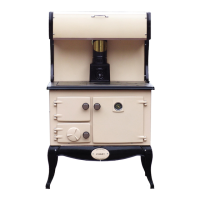MAIN OVEN
When baking or roasting, open the oven damper
and spin valve fully until the thermometer shows a
temperature about 50
o
F (10
o
C) higher than that
which is required. Then close the Spin Valve to a
point where the required temperature is sustained (a
little practice will soon show how much adjustment is
necessary). Much will also depend on the strength
of the chimney draught. Remember the direct flue
damper must be kept fully closed as a by-pass is
provided to allow waste gases through at all times.
When baking or roasting, if it is found that the sur-
face of the food is cooking too quickly then position
the plain steel shelf in the top of the oven so as to
act as a heat shield which will protect the food on the
shelf beneath.
THE HOTPLATE
Use the hotplate and the cooking-top of the range
for boiling simmering, frying, grilling, braising, etc.
Best results can be obtained by using flat bottomed
utensils. The lacquer which was applied to protect
the surface-ground hotplates will burn off and give a
strong odour during the burn off process. Keep the
hotplates clean with a wire brush. Over a short peri-
od you will quickly adapt to the best ways and
means of using the cooker-top in order to obtain
utmost satisfaction and efficiency.
The firebox may also be accessed by lifting the hot-
plate (Part No. 7) using the hotplate lifter (Part No.
67). Before the hotplate is moved, the hotplate
cleaning cups (Part No. 95) must be locked in posi-
tion by turning them clockwise, into the closed posi-
tion as shown in Fig.16.
HINTS ON FIRE SAFETY
To provide reasonable fire safety the following
should be given serious consideration:
1. The installation of smoke detectors.
2. A conveniently located Class A fire
extinguisher.
3. A practical evacuation plan.
4. A plan to deal with chimney fire as follows
(a) Notify the fire department
(b) Prepare occupants for immediate
evacuation.
(c) Close all openings into the stove
(d) While awaiting fire department,
watch for ignition of adjacent com
bustibles from overheated stove pipe
or hot embers or sparks from the
chimney.
NOTE: Inspect the chimney flue weekly until a safe
frequency is established.
OVER-FIRING
When using anthracite, coke or coal avoid excessive
firing conditions. High temperatures are unneces-
sary and can only do serious harm to the cooker.
The first indication that overheating is taking place
will be the formation of Clinker (Melted Ash) in the
firebox and this should be removed immediately oth-
erwise damage will occur not only to the cooker
components but also to the fire bricks and any dam-
age here should be repaired without delay.
11
Fig.16
USE OF TOOLS
Fig.17
Ash Pan
Lifting Tool
Soot
Cleaning

